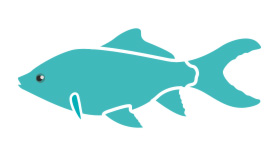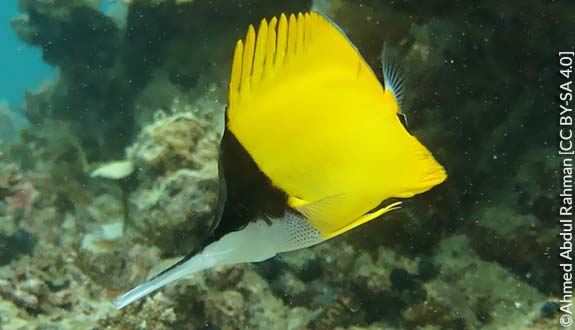

Alternative species (click on the thumbnail to see the card)
Names
Scientific name
Forcipiger longirostris
Chaetodon longirostris
Chelmo longirostris
Prognathodes longirostris
Forcipiger cyrano
Forcipiger inornatus
Common name
Longnose butterflyfish
Big longnose butterflyfish
Origin

Origin: Caribbean, Florida
Natural habitat: found up to 15 meters / 50 feet deep
Dimorphism

None
Group

Chaetodontidae
Volume

500 L / 110 Imp Gal / 132 US Gal
Parameters

T°: 24 to 26°C or 75 to 79°F
pH: 7.8 to 8.5
Density: 1021 to 1026
Difficulty

Hard
Size

18 to 25cm (7 to 9.8")
Longevity

10 to 15 years
Living zone

Middle and depth
Individuals

1
Food
How to feed the Longnose butterflyfish?
Food
How to feed the Longnose butterflyfish?
Easy to feed, the Forcipiger is carnivorous. You can offer it a diet composed mainly of small crustaceans such as artemia or mysis. Mussel or shrimp meat is also a good choice, as well as krill, mud worms or cut nereis. It will prefer live prey, or failing that frozen after a period of adaptation.
In order to stick as well as possible to its natural rhythm, make several small meals per day (in nature, it feeds throughout the day).
Behavior
What kind of behavior does the Longnose butterflyfish have?
Behavior
What kind of behavior does the Longnose butterflyfish have?
Although this fish is aggressive towards its fellow fish, it is very sociable and peaceful with other fish species. The same is true in the wild, where it lives exclusively solitary, with pairs forming only for the time of reproduction.
Once well settled, they roam peacefully through the landscape in search of prey.
Cohabitation
Who can live with the Longnose butterflyfish?
Cohabitation
Who can live with the Longnose butterflyfish?
Intolerant towards its congeners, only one representative of this species should be kept in an aquarium with a volume of less than 1000 L /220 Imp gal / 265 US Gal. On the other hand, it is very tolerant towards all other species.
The only cohabitation restrictions to report are with aggressive or very vivid territorial species that can stress it and disturb its daily activity.
Breeding
How to breed the Longnose butterflyfish?
Breeding
How to breed the Longnose butterflyfish?
Unknown in leisure aquarium hobby.
Its aquarium
Which aquarium for the Longnose butterflyfish?
Its aquarium
Which aquarium for the Longnose butterflyfish?
A rocky setting rich in animalcules (microscopic animals) is ideal for this pretty fish which will spend its time hunting them. It is also an essential element for the acclimatization of most specimens.
Very sensitive to the pollution of its environment, this fish requires a good filtration and a moderate current. Of course, it should only be introduced in a mature and very stable aquarium in order to avoid variations in water parameters.
If the Forcipiger is not correctly fed (in quality or quantity), it can attack corals. If this is the case, you should revise its diet (see "Food").
Good To know
Find all additional information!
Good To know
Find all additional information!
Beware of confusion with Forcipiger flavissimus. The most obvious difference is the size of the nose, proportionally longer in F.longirostris. F.longirostris also has lines of dark dots on the white part of its chest and flanks.
Its long tweeze-like beak is used to find prey between rocks and corals in its natural environment. Its name "longirostris" comes from the Latin "longus" meaning long and "rostrum" meaning beak. We leave it to you to associate the two notions :)
It is preferable to acquire young fish whose acclimatization is much easier.
There are darker forms of this species. Sensitive and difficult to acclimatize, the long-nosed butterflyfish is to be reserved for experienced aquarists (note that it is still quite robust once acclimatization is successful).
Yours photos!
Comments
Sort by:
Please login to post comments

